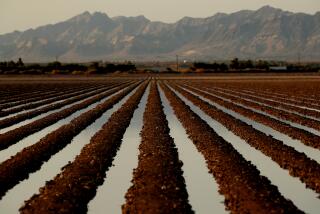An Essential Water Deal
- Share via
Enterprising farmers began drawing water from the Colorado River in 1901 to transform the Imperial Valley desert east of San Diego into a lush agricultural empire. Today, the Imperial Irrigation District sucks as much as 3.2 million acre-feet a year from the river to irrigate 450,000 acres of cropland--nearly six times the amount of water the city of Los Angeles uses in a year.
Why do crops come before people even as California’s growing population strains the state’s water supply? It’s not because growing crops in the desert makes more sense. It’s because state water law gives preference to those who got to the water first. About 80% of the water consumed statewide goes to agriculture and 20% to industry, homes and everything else. It’s long been obvious that the additional water needed to accommodate cities ultimately would come from farms. That time is now and the battleground is the Imperial Irrigation District.
Southern California has met demand by drawing far more water from the Colorado than it is legally entitled to--water belonging to Arizona, Nevada and other Colorado Basin states. Now those states are growing too and have demanded their full shares.
The Imperial Irrigation District drew attention decades ago because it was losing huge amounts of water through leaky canals and wasteful irrigation practices. The district struck a pioneering deal with urban Southern California’s big water wholesaler, the Metropolitan Water District, in the mid-1980s. Metropolitan financed conservation facilities for Imperial and in return took the water it saved.
A far larger, 75-year agreement was reached by Imperial and the San Diego County Water Agency in the late 1990s to transfer enough water to San Diego to supply the household needs of 400,000 families. The deal is essential to offsetting the loss of Colorado River water.
Gov. Gray Davis, federal officials and leaders of the other big Southern California water districts now say Imperial should take enough land out of production to provide the needed water. This has touched off anger and anguish in the Imperial Valley, which has long feared a big-city water grab similar to Los Angeles’ raid of Owens Valley water early in the 20th century. The farmers would be paid well for fallowing the land, but the ripple effect would hurt farm workers and businesses that live off crop production. Imperial water agency leaders are threatening to back out of the San Diego agreement.
If the sale of farm water to San Diego falls through, the Colorado River cuts will have to come from somewhere else. The federal government says it will slash coastal Southern California’s Colorado River supply, which would trigger water rationing and shrivel the economy.
Davis, the Bush administration and others must find a way to make the Imperial-San Diego trade work. If that includes easing the economic impact on the farm region overall, Imperial will be reassured that any future water trades won’t be Owens Valley-style grabs.
More to Read
Sign up for Essential California
The most important California stories and recommendations in your inbox every morning.
You may occasionally receive promotional content from the Los Angeles Times.










